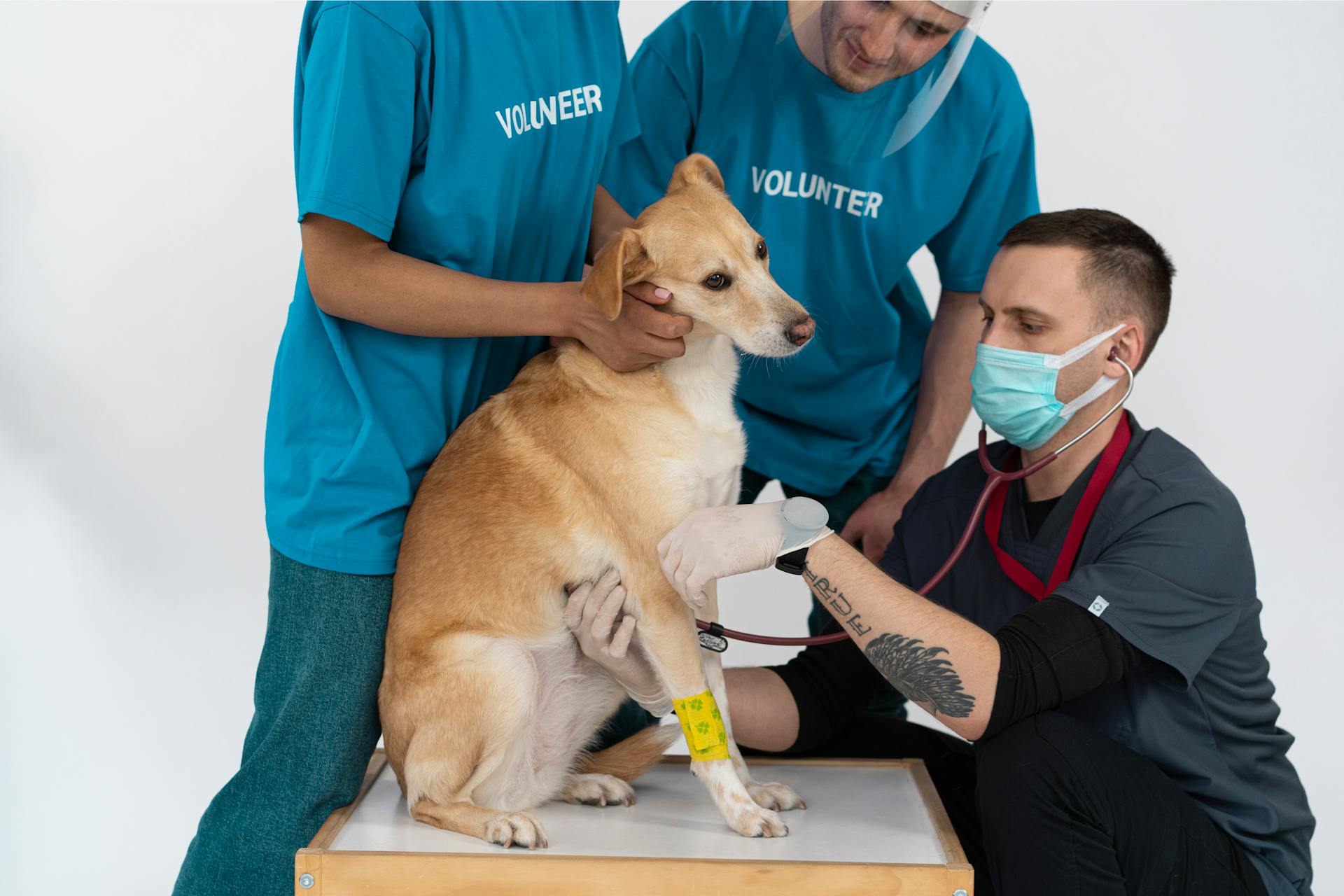
As a parent, there's nothing more precious than seeing your child's face light up when they interact with a furry friend. However, it's essential to teach your kids how to safely interact with dogs to avoid any potential harm.
Dogs can be unpredictable, especially around children, so it's crucial to establish clear rules and boundaries. According to a study, children under the age of 5 are more likely to be bitten by a dog, making it essential to supervise interactions closely.
Teaching your kids basic dog safety skills from a young age can make all the difference. One simple rule is to never touch a dog while it's eating or sleeping.
Consider reading: Dog Training for Kids
Preventing Dog Bites
Preventing dog bites is a crucial aspect of dog safety for kids. All dogs can bite, regardless of their size, breed, or typical personality.
Dogs are not machines, they have complex emotions and internal experiences that affect their behavior. A dog who used to enjoy interacting with children may no longer find it comfortable or fun as they age.
Pain or illness can play a huge factor in bite incidents with children, and dogs are quite good at hiding pain. Dogs who are startled are more likely to bite, such as if they are suddenly woken up from sleeping to find a child right up next to them.
To prevent dog bites, carefully select your pet and don't get a puppy on impulse. Your veterinarian is your best source for information about behavior, health, and suitability.
Socialize your pet so he/she feels at ease around people and other animals. Gradually expose your puppy to a variety of situations under controlled circumstances; continue that exposure on a regular basis as your dog gets older.
Take extra care with young children. Always supervise their interaction with dogs, including your own dogs. Carefully manage the introduction of a child or a new dog to your household.
Train your dog with basic commands like "sit", "stay", "no", and "come." Use a leash in public to ensure you are able to control your dog. Avoid highly excitable games like wrestling or tug-of-war.
Keep your dog healthy by having your dog vaccinated against rabies and preventable infectious diseases. Parasite control and overall health care are important because how your dog feels directly affects how it behaves.
Explore further: Dog Food Aggression towards Child
Here are some additional tips to prevent dog bites:
- Make sure your dog is secured in a separate room, crate, or fenced area.
- Place visible signs on your door or your property to warn delivery personnel about the presence of a dog.
- If possible, notify delivery services about your dog and any special instructions for delivering packages to your home.
- Regularly monitor your dog's behavior and consult with a veterinarian if you notice any signs of aggression.
Teaching Kids About Dogs
As you're teaching your kids about dogs, it's essential to start with the basics of respect. Teach your child to respect dogs' personal space, comfort, and ability to make their own decisions. This means not pulling on their tails, ears, legs, or fur, and not poking at their eyes or mouth.
Respect also involves not hugging excessively, pushing, or leaning down on the dog. Never let your child handle your dog roughly or in any way that your dog doesn't like. This is asking to be bitten.
One simple rule to teach your kids is to kneel down to the side of the dog with shoulders parallel to theirs when first meeting. Avoid direct eye contact and offer soft and slow blinks, which dogs perceive as de-escalatory behavior and work as a calming signal.
If the dog approaches you, gently pet their underneath their chin, on their chest, or their back. These are the spots where dogs are most comfortable being touched. Take frequent breaks every 3 strokes and perform a consent check to assess if the dog is still interested in pets.
Suggestion: Teach Dog
Here are some essential dog body language signs to teach your kids:
Teaching your kids to recognize these signs will help them understand when a dog is feeling uncomfortable or threatened. By doing so, they can take steps to prevent an unfortunate situation from arising.
Dog Safety Education
Doggone Safe is a great resource for promoting education initiatives on dog bite prevention and child safety around dogs. They provide low-cost educational materials for schools and community health departments to use.
These materials can be displayed in veterinarians' and family physicians' offices to educate pet owners and parents about dog safety. By providing tools and resources, Doggone Safe supports dog bite prevention education.
You can join Doggone Safe to access their programs, educational resources, and member area. This is a great way to get involved and learn more about dog safety.
Here are some of the programs and resources available through Doggone Safe:
- Programs
- Educational Resources
- Member Area
- Directory
- Webinars
Understanding Dog Behavior
Dogs can't talk to us, so they use body language, vocalizations, and postures to express themselves.
Dogs have unique personalities, so it's not always easy to read their body language accurately. One dog's wagging tail might mean they're happy to see you, while another dog's wagging tail might mean they're anxious.
If a dog is feeling worried, they might yawn, put their ears back, or raise a paw. As they get more concerned, their behavior will change.
Some dogs will tuck their tail under their belly or leg, lie down with a leg up, or stiffen their body and stare at you when they're frightened or threatened.
If a dog is growling, snapping, or biting, they're telling you they want to be left alone.
You can't predict whether a dog will bite or not based on their size and breed, so always focus on their behavior.
If a dog seems relaxed and friendly, and seems happy to see you, they're probably in a good, playful mood and will welcome your attention. If they're avoiding you or seem tense and nervous, it's best to stay away.
For your interest: Dog Body Language with Other Dogs
Always rely on the dog's owner to help you understand the pet's mood, and always ask the owner's permission before attempting to pet a dog you don't know.
Here are some common signs that a dog might be feeling stressed or threatened:
• Tucking their tail under their belly or leg
• Lying down with a leg up
• Stiffening their body and staring at you
• Growling, snapping, or biting
Creating a Safe Environment
To promote a safe environment for kids and dogs, it's essential to designate a "safe place" for your dog, where they can retreat when feeling stressed. This can be a room or area within the home where the dog can easily go without being disturbed.
Be sure to teach children to respect a dog's space and never leave them unobserved around any dog. Active and proactive supervision is a must, especially when kids are interacting with dogs.
Here are some tips to help you manage space and create a safe environment:
- Designate a safe space for your dog, where they can retreat when feeling stressed.
- Teach children to respect a dog's space and never leave them unobserved around any dog.
- Use a crate or safe space when your dog is eating meals or has a chew or toy they value.
- Never let your children grab at the dog's toys, and teach them how to stay at a distance when your dog is enjoying their things or eating their meals.
Protecting Yourself and Family
Creating a safe environment for yourself and your family requires being mindful of your surroundings, especially when it comes to dogs. Never leave a baby or small child alone with a dog.
Children are the most common victims of dog bites, so it's essential to teach them how to interact with pets safely. Be alert for potentially dangerous situations and take measures to prevent or stop them from escalating.
To prevent dog bites, it's crucial to be aware of your actions around dogs. Don't run past a dog, as this can trigger their natural instinct to chase and catch.
Here are some key tips to keep in mind:
- Never leave a baby or small child alone with a dog.
- Don't run past a dog.
- Never disturb a dog that's caring for puppies, sleeping, or eating.
- Never reach through or over a fence to pet a dog.
- Stay still if a dog approaches to sniff you.
By following these simple tips, you can significantly reduce the risk of dog bites and create a safer environment for yourself and your family.
Manage Space
Designating a safe space for your dog is a must. This can be a room or area within the home where your dog can easily go when stressed.

All members of the household need to know not to disturb the dog when they're in their safe space. This is crucial for the dog's comfort and well-being.
A safe space can be set up by following the steps found here. This will help create a designated area for your dog to retreat to when needed.
Active and proactive supervision is necessary when young children and dogs interact. This means never leaving your child unobserved around the dog.
If you can't be actively supervising, put the dog in a separate space from your child, such as a room behind a gate or in their crate if they're crate trained.
Resources, like toys and food, can be a source of conflict between children and dogs. Separate your dog from your children when they're eating meals or have a valuable toy.
Never let your children grab at the dog's toys, and teach them to stay at a distance when the dog is enjoying their things or eating meals.
Broaden your view: Dog Safe Ant Poison
Sources
- https://www.patriciamcconnell.com/theotherendoftheleash/keeping-kids-and-dogs-safe
- https://www.preventivevet.com/dogs/prevent-dog-bites-with-children
- https://www.avma.org/resources-tools/pet-owners/dog-bite-prevention
- https://www.petprofessionalguild.com/programs/doggone-safe/
- https://resources.sdhumane.org/Resource_Center/Behavior_and_Training/Dogs_and_Puppies/Dog_Bite_Prevention/Safety%3A_Dogs_and_Young_Children
Featured Images: pexels.com


